Strategic Human Resource Management Report - HRM 325 Analysis
VerifiedAdded on 2020/09/09
|21
|4357
|123
Report
AI Summary
This report, submitted by a student at the University of Sunderland London, examines strategic human resource management (SHRM). It begins by exploring the relationship between business and human resource strategies, emphasizing vertical alignment and horizontal integration. The report critically evaluates various SHRM theoretical models, including Best Fit/Contingency, Best Practice/Universalist, and the Resource Based View (RBV), comparing and contrasting their approaches. Furthermore, it delves into specific HR practices, focusing on performance management and reward systems, analyzing their impact on employee motivation and organizational goals. The report then shifts to employment relations, discussing theoretical perspectives such as Unitarist, Pluralist, and Marxist views, and identifying the roles of different actors. It analyzes the changing nature of employment relations and provides recommendations for improving these relations through employee participation and voice mechanisms. The report concludes by summarizing key findings and recommendations for businesses seeking to optimize their HRM strategies.
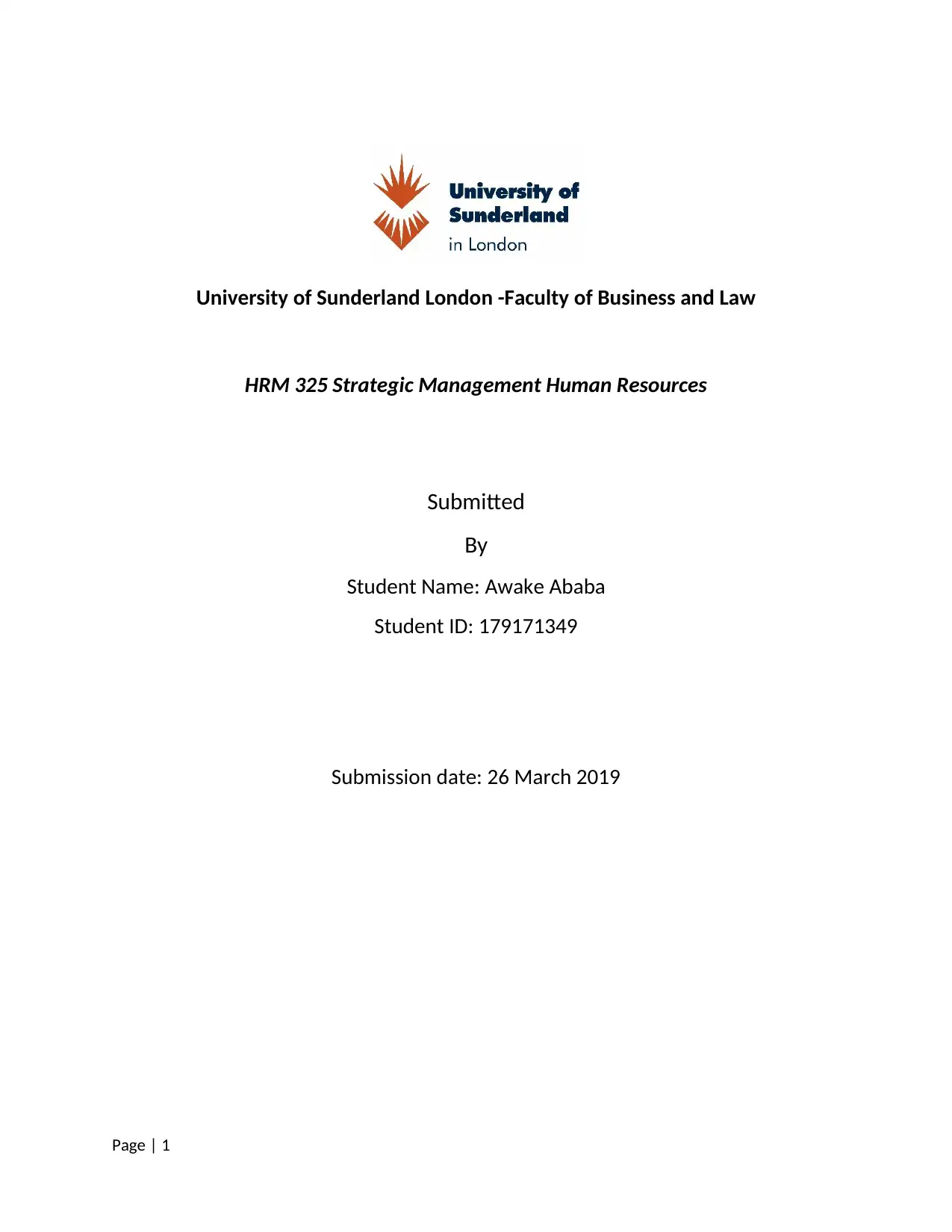
University of Sunderland London -Faculty of Business and Law
HRM 325 Strategic Management Human Resources
Submitted
By
Student Name: Awake Ababa
Student ID: 179171349
Submission date: 26 March 2019
Page | 1
HRM 325 Strategic Management Human Resources
Submitted
By
Student Name: Awake Ababa
Student ID: 179171349
Submission date: 26 March 2019
Page | 1
Paraphrase This Document
Need a fresh take? Get an instant paraphrase of this document with our AI Paraphraser
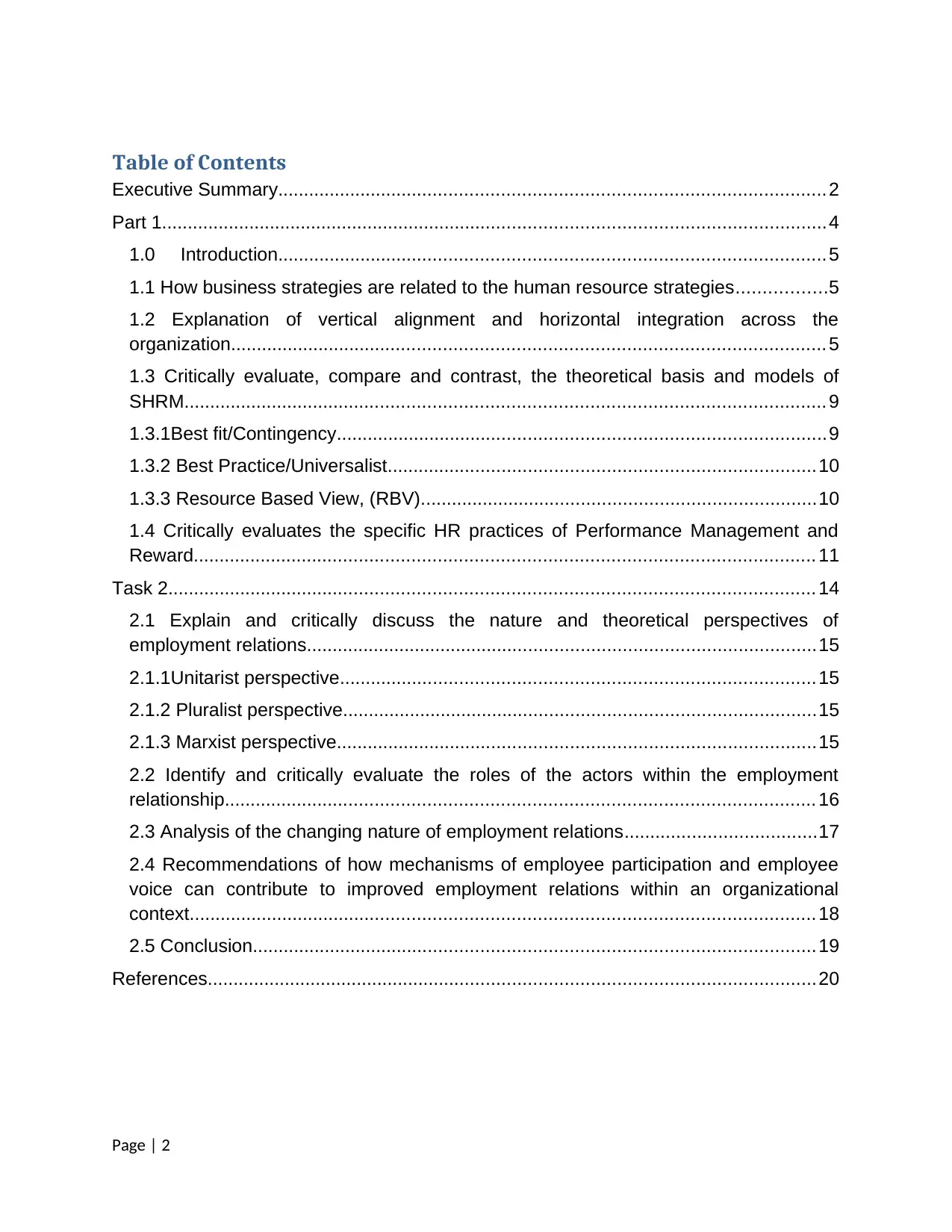
Table of Contents
Executive Summary......................................................................................................... 2
Part 1................................................................................................................................4
1.0 Introduction......................................................................................................... 5
1.1 How business strategies are related to the human resource strategies.................5
1.2 Explanation of vertical alignment and horizontal integration across the
organization.................................................................................................................. 5
1.3 Critically evaluate, compare and contrast, the theoretical basis and models of
SHRM........................................................................................................................... 9
1.3.1Best fit/Contingency..............................................................................................9
1.3.2 Best Practice/Universalist..................................................................................10
1.3.3 Resource Based View, (RBV)............................................................................10
1.4 Critically evaluates the specific HR practices of Performance Management and
Reward....................................................................................................................... 11
Task 2............................................................................................................................ 14
2.1 Explain and critically discuss the nature and theoretical perspectives of
employment relations..................................................................................................15
2.1.1Unitarist perspective........................................................................................... 15
2.1.2 Pluralist perspective...........................................................................................15
2.1.3 Marxist perspective............................................................................................15
2.2 Identify and critically evaluate the roles of the actors within the employment
relationship................................................................................................................. 16
2.3 Analysis of the changing nature of employment relations.....................................17
2.4 Recommendations of how mechanisms of employee participation and employee
voice can contribute to improved employment relations within an organizational
context........................................................................................................................ 18
2.5 Conclusion............................................................................................................ 19
References.....................................................................................................................20
Page | 2
Executive Summary......................................................................................................... 2
Part 1................................................................................................................................4
1.0 Introduction......................................................................................................... 5
1.1 How business strategies are related to the human resource strategies.................5
1.2 Explanation of vertical alignment and horizontal integration across the
organization.................................................................................................................. 5
1.3 Critically evaluate, compare and contrast, the theoretical basis and models of
SHRM........................................................................................................................... 9
1.3.1Best fit/Contingency..............................................................................................9
1.3.2 Best Practice/Universalist..................................................................................10
1.3.3 Resource Based View, (RBV)............................................................................10
1.4 Critically evaluates the specific HR practices of Performance Management and
Reward....................................................................................................................... 11
Task 2............................................................................................................................ 14
2.1 Explain and critically discuss the nature and theoretical perspectives of
employment relations..................................................................................................15
2.1.1Unitarist perspective........................................................................................... 15
2.1.2 Pluralist perspective...........................................................................................15
2.1.3 Marxist perspective............................................................................................15
2.2 Identify and critically evaluate the roles of the actors within the employment
relationship................................................................................................................. 16
2.3 Analysis of the changing nature of employment relations.....................................17
2.4 Recommendations of how mechanisms of employee participation and employee
voice can contribute to improved employment relations within an organizational
context........................................................................................................................ 18
2.5 Conclusion............................................................................................................ 19
References.....................................................................................................................20
Page | 2
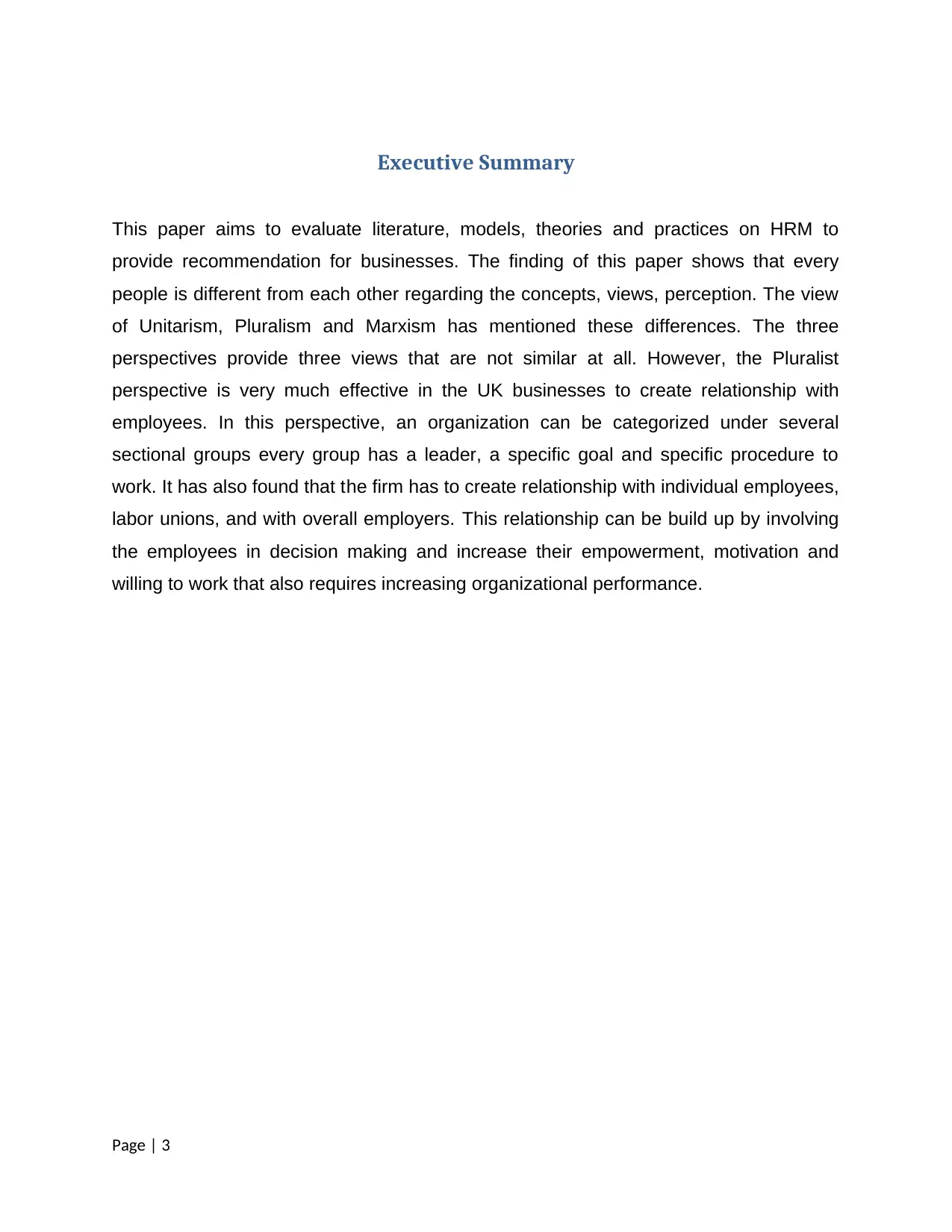
Executive Summary
This paper aims to evaluate literature, models, theories and practices on HRM to
provide recommendation for businesses. The finding of this paper shows that every
people is different from each other regarding the concepts, views, perception. The view
of Unitarism, Pluralism and Marxism has mentioned these differences. The three
perspectives provide three views that are not similar at all. However, the Pluralist
perspective is very much effective in the UK businesses to create relationship with
employees. In this perspective, an organization can be categorized under several
sectional groups every group has a leader, a specific goal and specific procedure to
work. It has also found that the firm has to create relationship with individual employees,
labor unions, and with overall employers. This relationship can be build up by involving
the employees in decision making and increase their empowerment, motivation and
willing to work that also requires increasing organizational performance.
Page | 3
This paper aims to evaluate literature, models, theories and practices on HRM to
provide recommendation for businesses. The finding of this paper shows that every
people is different from each other regarding the concepts, views, perception. The view
of Unitarism, Pluralism and Marxism has mentioned these differences. The three
perspectives provide three views that are not similar at all. However, the Pluralist
perspective is very much effective in the UK businesses to create relationship with
employees. In this perspective, an organization can be categorized under several
sectional groups every group has a leader, a specific goal and specific procedure to
work. It has also found that the firm has to create relationship with individual employees,
labor unions, and with overall employers. This relationship can be build up by involving
the employees in decision making and increase their empowerment, motivation and
willing to work that also requires increasing organizational performance.
Page | 3
⊘ This is a preview!⊘
Do you want full access?
Subscribe today to unlock all pages.

Trusted by 1+ million students worldwide

Part 1
Page | 4
Page | 4
Paraphrase This Document
Need a fresh take? Get an instant paraphrase of this document with our AI Paraphraser
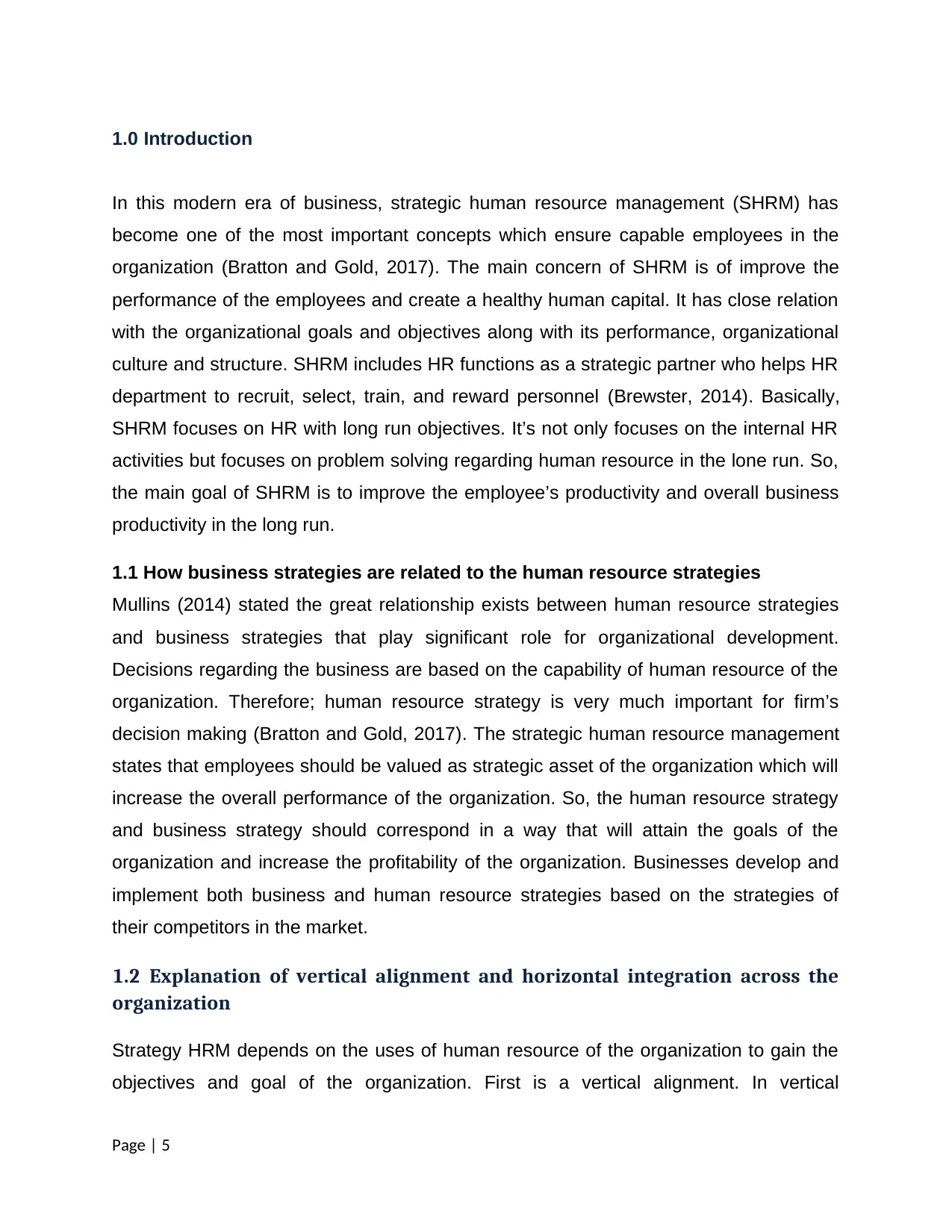
1.0 Introduction
In this modern era of business, strategic human resource management (SHRM) has
become one of the most important concepts which ensure capable employees in the
organization (Bratton and Gold, 2017). The main concern of SHRM is of improve the
performance of the employees and create a healthy human capital. It has close relation
with the organizational goals and objectives along with its performance, organizational
culture and structure. SHRM includes HR functions as a strategic partner who helps HR
department to recruit, select, train, and reward personnel (Brewster, 2014). Basically,
SHRM focuses on HR with long run objectives. It’s not only focuses on the internal HR
activities but focuses on problem solving regarding human resource in the lone run. So,
the main goal of SHRM is to improve the employee’s productivity and overall business
productivity in the long run.
1.1 How business strategies are related to the human resource strategies
Mullins (2014) stated the great relationship exists between human resource strategies
and business strategies that play significant role for organizational development.
Decisions regarding the business are based on the capability of human resource of the
organization. Therefore; human resource strategy is very much important for firm’s
decision making (Bratton and Gold, 2017). The strategic human resource management
states that employees should be valued as strategic asset of the organization which will
increase the overall performance of the organization. So, the human resource strategy
and business strategy should correspond in a way that will attain the goals of the
organization and increase the profitability of the organization. Businesses develop and
implement both business and human resource strategies based on the strategies of
their competitors in the market.
1.2 Explanation of vertical alignment and horizontal integration across the
organization
Strategy HRM depends on the uses of human resource of the organization to gain the
objectives and goal of the organization. First is a vertical alignment. In vertical
Page | 5
In this modern era of business, strategic human resource management (SHRM) has
become one of the most important concepts which ensure capable employees in the
organization (Bratton and Gold, 2017). The main concern of SHRM is of improve the
performance of the employees and create a healthy human capital. It has close relation
with the organizational goals and objectives along with its performance, organizational
culture and structure. SHRM includes HR functions as a strategic partner who helps HR
department to recruit, select, train, and reward personnel (Brewster, 2014). Basically,
SHRM focuses on HR with long run objectives. It’s not only focuses on the internal HR
activities but focuses on problem solving regarding human resource in the lone run. So,
the main goal of SHRM is to improve the employee’s productivity and overall business
productivity in the long run.
1.1 How business strategies are related to the human resource strategies
Mullins (2014) stated the great relationship exists between human resource strategies
and business strategies that play significant role for organizational development.
Decisions regarding the business are based on the capability of human resource of the
organization. Therefore; human resource strategy is very much important for firm’s
decision making (Bratton and Gold, 2017). The strategic human resource management
states that employees should be valued as strategic asset of the organization which will
increase the overall performance of the organization. So, the human resource strategy
and business strategy should correspond in a way that will attain the goals of the
organization and increase the profitability of the organization. Businesses develop and
implement both business and human resource strategies based on the strategies of
their competitors in the market.
1.2 Explanation of vertical alignment and horizontal integration across the
organization
Strategy HRM depends on the uses of human resource of the organization to gain the
objectives and goal of the organization. First is a vertical alignment. In vertical
Page | 5
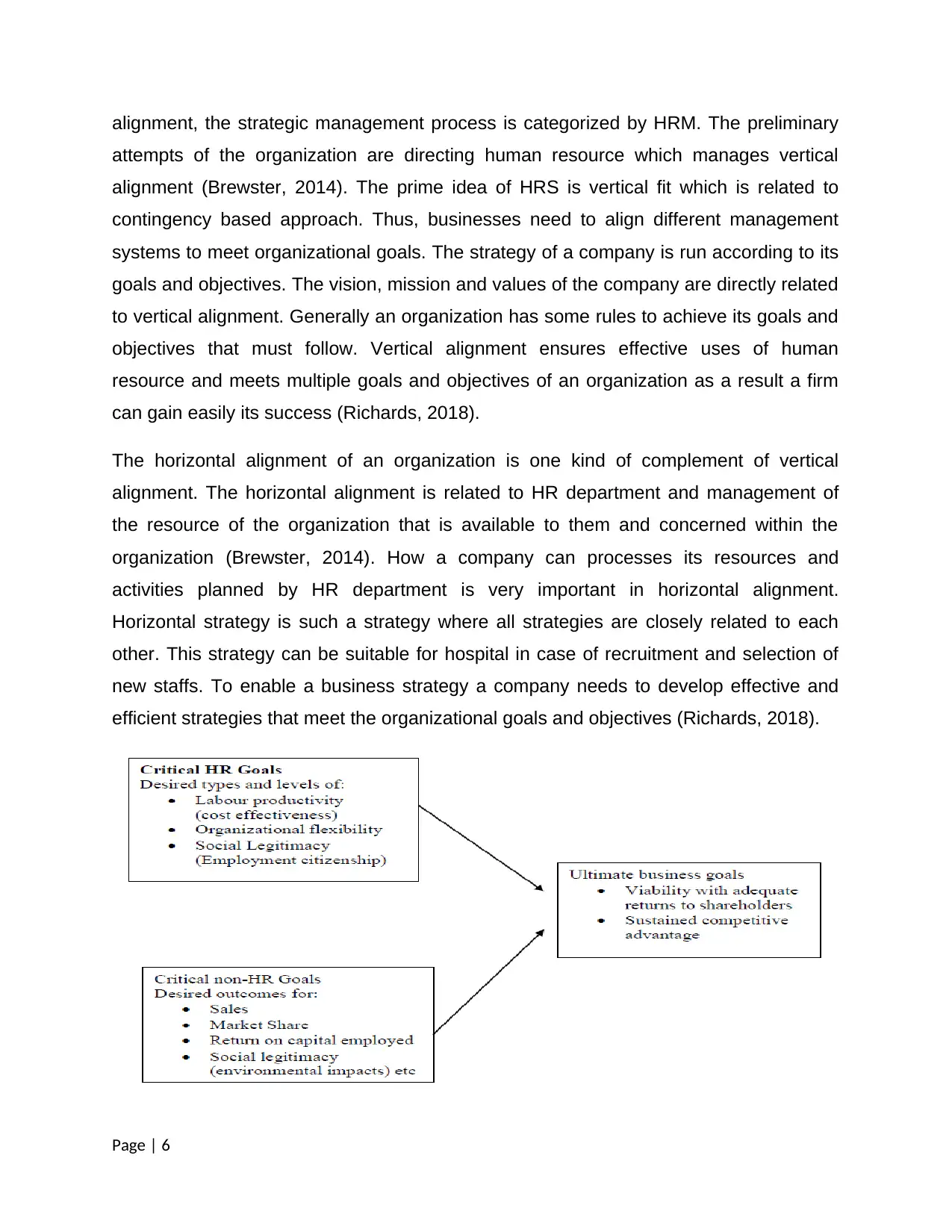
alignment, the strategic management process is categorized by HRM. The preliminary
attempts of the organization are directing human resource which manages vertical
alignment (Brewster, 2014). The prime idea of HRS is vertical fit which is related to
contingency based approach. Thus, businesses need to align different management
systems to meet organizational goals. The strategy of a company is run according to its
goals and objectives. The vision, mission and values of the company are directly related
to vertical alignment. Generally an organization has some rules to achieve its goals and
objectives that must follow. Vertical alignment ensures effective uses of human
resource and meets multiple goals and objectives of an organization as a result a firm
can gain easily its success (Richards, 2018).
The horizontal alignment of an organization is one kind of complement of vertical
alignment. The horizontal alignment is related to HR department and management of
the resource of the organization that is available to them and concerned within the
organization (Brewster, 2014). How a company can processes its resources and
activities planned by HR department is very important in horizontal alignment.
Horizontal strategy is such a strategy where all strategies are closely related to each
other. This strategy can be suitable for hospital in case of recruitment and selection of
new staffs. To enable a business strategy a company needs to develop effective and
efficient strategies that meet the organizational goals and objectives (Richards, 2018).
Page | 6
attempts of the organization are directing human resource which manages vertical
alignment (Brewster, 2014). The prime idea of HRS is vertical fit which is related to
contingency based approach. Thus, businesses need to align different management
systems to meet organizational goals. The strategy of a company is run according to its
goals and objectives. The vision, mission and values of the company are directly related
to vertical alignment. Generally an organization has some rules to achieve its goals and
objectives that must follow. Vertical alignment ensures effective uses of human
resource and meets multiple goals and objectives of an organization as a result a firm
can gain easily its success (Richards, 2018).
The horizontal alignment of an organization is one kind of complement of vertical
alignment. The horizontal alignment is related to HR department and management of
the resource of the organization that is available to them and concerned within the
organization (Brewster, 2014). How a company can processes its resources and
activities planned by HR department is very important in horizontal alignment.
Horizontal strategy is such a strategy where all strategies are closely related to each
other. This strategy can be suitable for hospital in case of recruitment and selection of
new staffs. To enable a business strategy a company needs to develop effective and
efficient strategies that meet the organizational goals and objectives (Richards, 2018).
Page | 6
⊘ This is a preview!⊘
Do you want full access?
Subscribe today to unlock all pages.

Trusted by 1+ million students worldwide
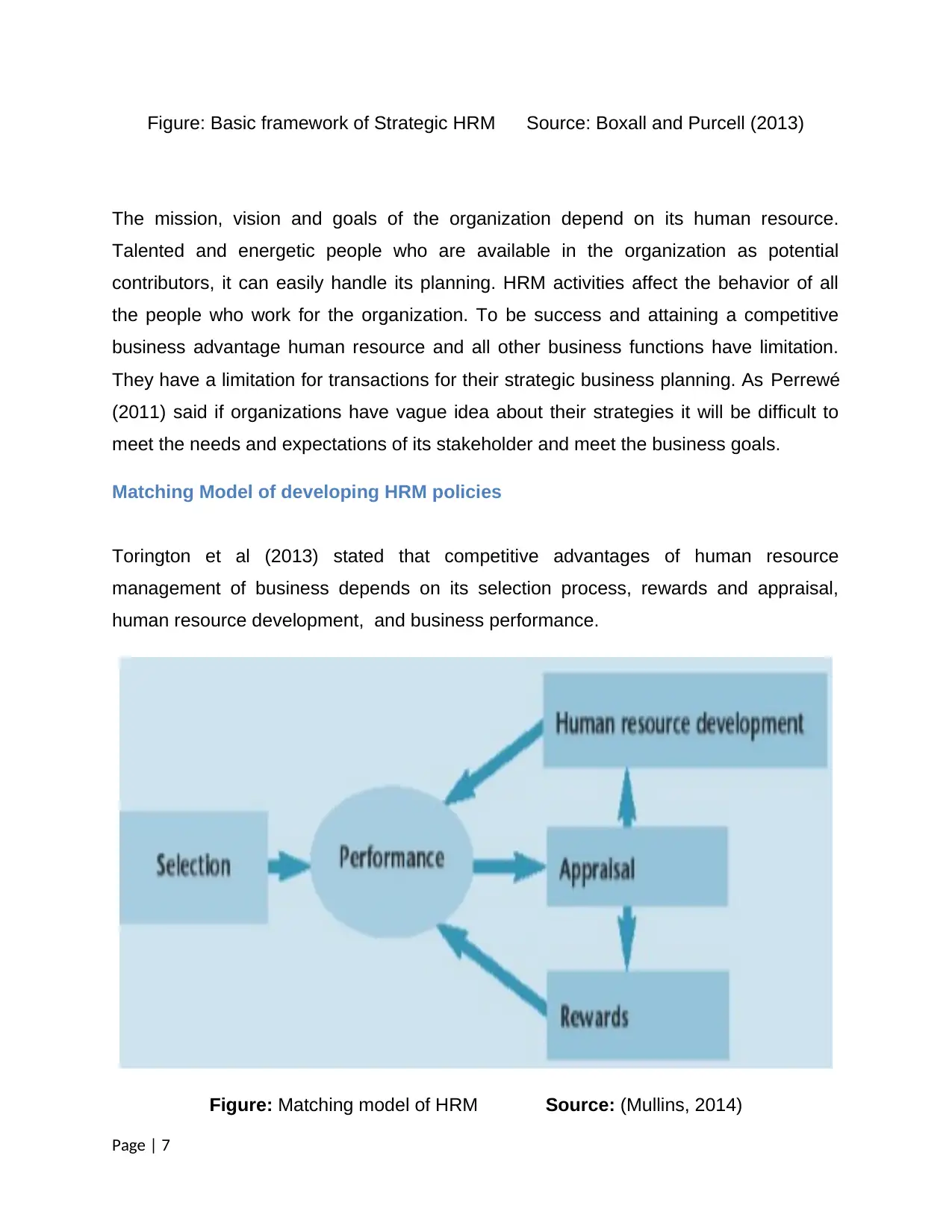
Figure: Basic framework of Strategic HRM Source: Boxall and Purcell (2013)
The mission, vision and goals of the organization depend on its human resource.
Talented and energetic people who are available in the organization as potential
contributors, it can easily handle its planning. HRM activities affect the behavior of all
the people who work for the organization. To be success and attaining a competitive
business advantage human resource and all other business functions have limitation.
They have a limitation for transactions for their strategic business planning. As Perrewé
(2011) said if organizations have vague idea about their strategies it will be difficult to
meet the needs and expectations of its stakeholder and meet the business goals.
Matching Model of developing HRM policies
Torington et al (2013) stated that competitive advantages of human resource
management of business depends on its selection process, rewards and appraisal,
human resource development, and business performance.
Figure: Matching model of HRM Source: (Mullins, 2014)
Page | 7
The mission, vision and goals of the organization depend on its human resource.
Talented and energetic people who are available in the organization as potential
contributors, it can easily handle its planning. HRM activities affect the behavior of all
the people who work for the organization. To be success and attaining a competitive
business advantage human resource and all other business functions have limitation.
They have a limitation for transactions for their strategic business planning. As Perrewé
(2011) said if organizations have vague idea about their strategies it will be difficult to
meet the needs and expectations of its stakeholder and meet the business goals.
Matching Model of developing HRM policies
Torington et al (2013) stated that competitive advantages of human resource
management of business depends on its selection process, rewards and appraisal,
human resource development, and business performance.
Figure: Matching model of HRM Source: (Mullins, 2014)
Page | 7
Paraphrase This Document
Need a fresh take? Get an instant paraphrase of this document with our AI Paraphraser
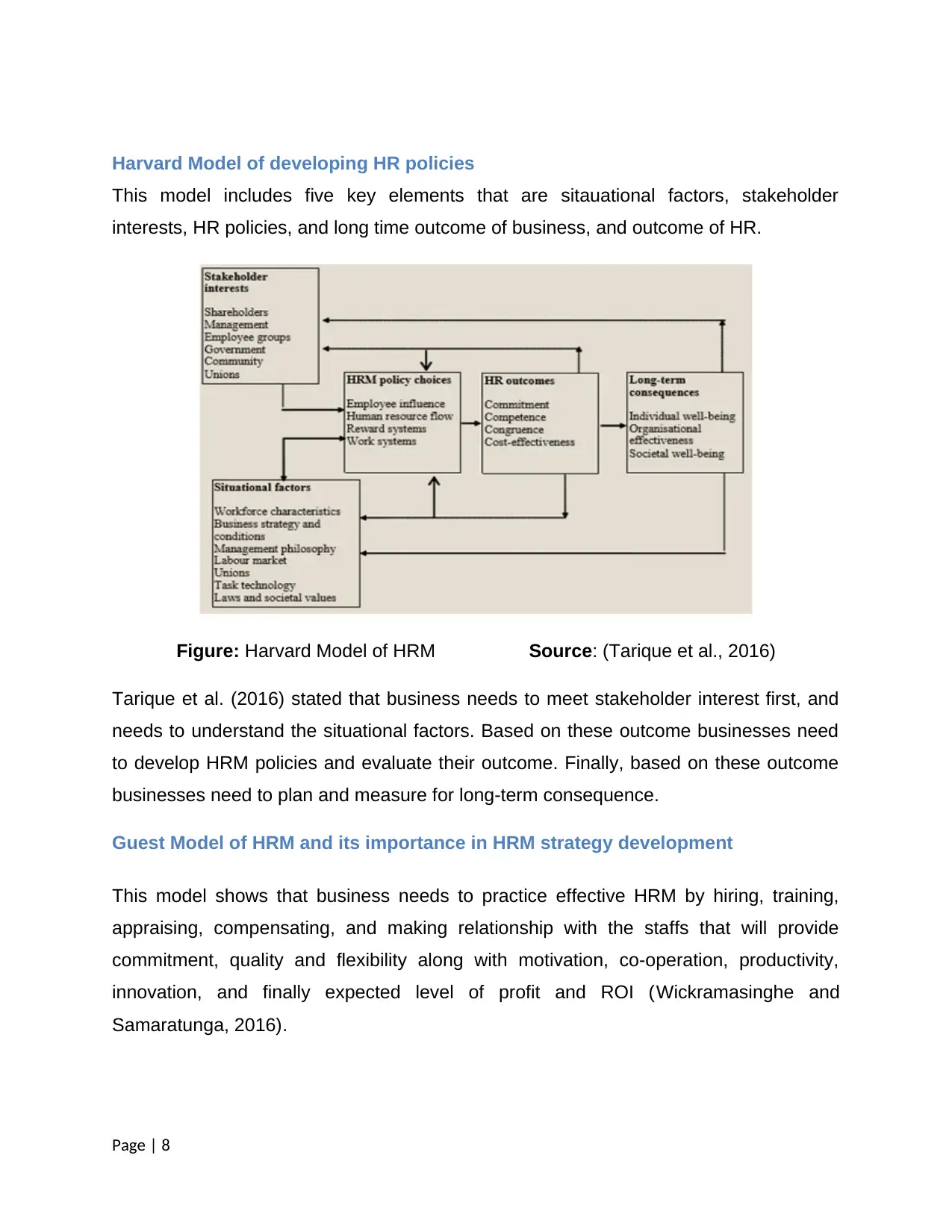
Harvard Model of developing HR policies
This model includes five key elements that are sitauational factors, stakeholder
interests, HR policies, and long time outcome of business, and outcome of HR.
Figure: Harvard Model of HRM Source: (Tarique et al., 2016)
Tarique et al. (2016) stated that business needs to meet stakeholder interest first, and
needs to understand the situational factors. Based on these outcome businesses need
to develop HRM policies and evaluate their outcome. Finally, based on these outcome
businesses need to plan and measure for long-term consequence.
Guest Model of HRM and its importance in HRM strategy development
This model shows that business needs to practice effective HRM by hiring, training,
appraising, compensating, and making relationship with the staffs that will provide
commitment, quality and flexibility along with motivation, co-operation, productivity,
innovation, and finally expected level of profit and ROI (Wickramasinghe and
Samaratunga, 2016).
Page | 8
This model includes five key elements that are sitauational factors, stakeholder
interests, HR policies, and long time outcome of business, and outcome of HR.
Figure: Harvard Model of HRM Source: (Tarique et al., 2016)
Tarique et al. (2016) stated that business needs to meet stakeholder interest first, and
needs to understand the situational factors. Based on these outcome businesses need
to develop HRM policies and evaluate their outcome. Finally, based on these outcome
businesses need to plan and measure for long-term consequence.
Guest Model of HRM and its importance in HRM strategy development
This model shows that business needs to practice effective HRM by hiring, training,
appraising, compensating, and making relationship with the staffs that will provide
commitment, quality and flexibility along with motivation, co-operation, productivity,
innovation, and finally expected level of profit and ROI (Wickramasinghe and
Samaratunga, 2016).
Page | 8
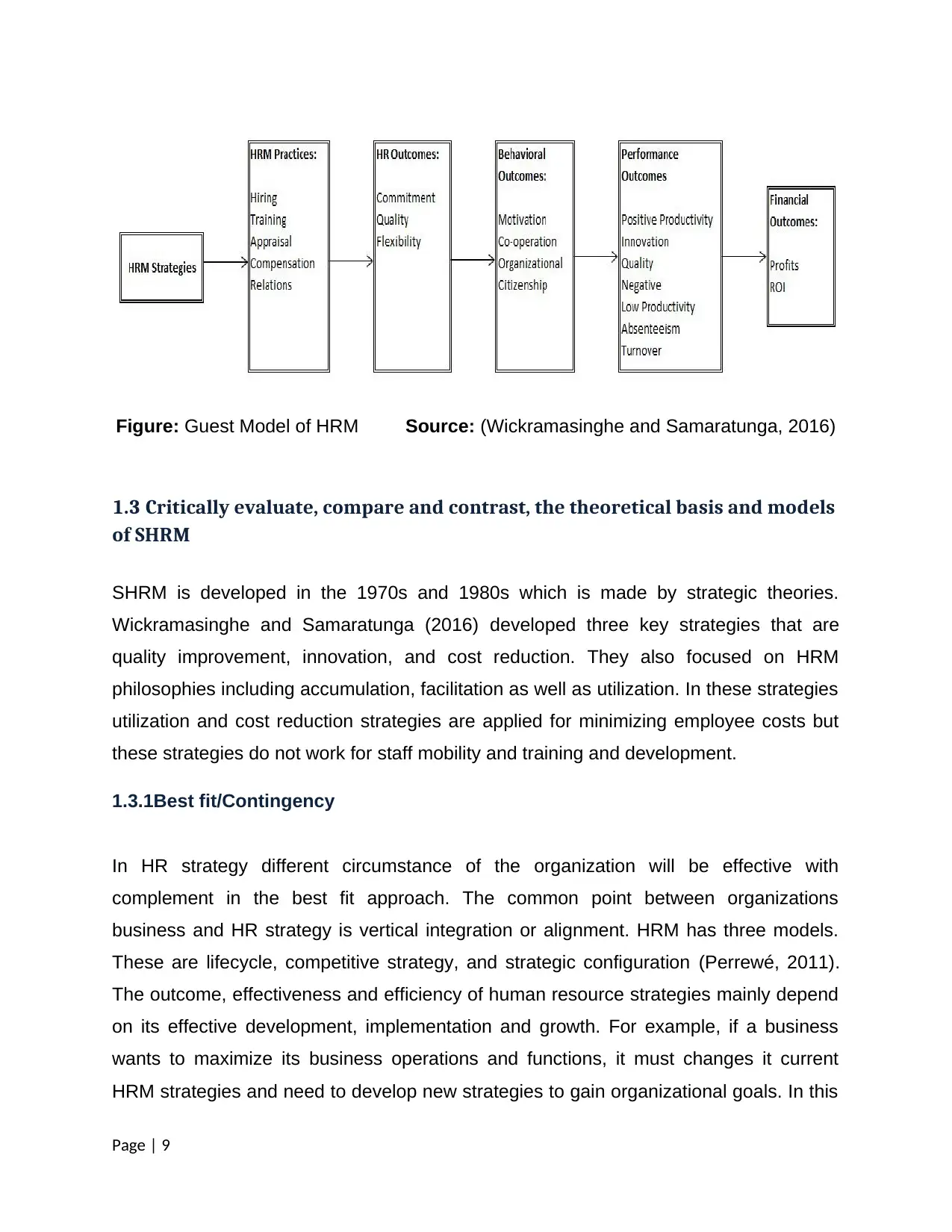
Figure: Guest Model of HRM Source: (Wickramasinghe and Samaratunga, 2016)
1.3 Critically evaluate, compare and contrast, the theoretical basis and models
of SHRM
SHRM is developed in the 1970s and 1980s which is made by strategic theories.
Wickramasinghe and Samaratunga (2016) developed three key strategies that are
quality improvement, innovation, and cost reduction. They also focused on HRM
philosophies including accumulation, facilitation as well as utilization. In these strategies
utilization and cost reduction strategies are applied for minimizing employee costs but
these strategies do not work for staff mobility and training and development.
1.3.1Best fit/Contingency
In HR strategy different circumstance of the organization will be effective with
complement in the best fit approach. The common point between organizations
business and HR strategy is vertical integration or alignment. HRM has three models.
These are lifecycle, competitive strategy, and strategic configuration (Perrewé, 2011).
The outcome, effectiveness and efficiency of human resource strategies mainly depend
on its effective development, implementation and growth. For example, if a business
wants to maximize its business operations and functions, it must changes it current
HRM strategies and need to develop new strategies to gain organizational goals. In this
Page | 9
1.3 Critically evaluate, compare and contrast, the theoretical basis and models
of SHRM
SHRM is developed in the 1970s and 1980s which is made by strategic theories.
Wickramasinghe and Samaratunga (2016) developed three key strategies that are
quality improvement, innovation, and cost reduction. They also focused on HRM
philosophies including accumulation, facilitation as well as utilization. In these strategies
utilization and cost reduction strategies are applied for minimizing employee costs but
these strategies do not work for staff mobility and training and development.
1.3.1Best fit/Contingency
In HR strategy different circumstance of the organization will be effective with
complement in the best fit approach. The common point between organizations
business and HR strategy is vertical integration or alignment. HRM has three models.
These are lifecycle, competitive strategy, and strategic configuration (Perrewé, 2011).
The outcome, effectiveness and efficiency of human resource strategies mainly depend
on its effective development, implementation and growth. For example, if a business
wants to maximize its business operations and functions, it must changes it current
HRM strategies and need to develop new strategies to gain organizational goals. In this
Page | 9
⊘ This is a preview!⊘
Do you want full access?
Subscribe today to unlock all pages.

Trusted by 1+ million students worldwide

case, Porter (1985) developed the best fit competitive strategies that focus on quality,
innovation, and cost leadership strategies.
1.3.2 Best Practice/Universalist
The best practice strategy
This strategy aims planning that is matching with the universal sense. It is such-a
approach that will be correct in any situation. This approach helps the organization to
gain its goals. It helps to make the best planning for the organization. Brewster (2014)
argued for 7 best practices. These include sharing information, differentiations,
workforce motivation, skill development of staffs, rewards and incentives, self-managed
teams, and effective recruitment and selection. On the other hand, Guest focuses on
five key practices that are staff motivation and commitment, staff communication,
effective job design, and effective recruitment, and effective training. Demery and Doty
have given seven strategies for HR practices. These include job designs, employee
freedom and their security and privacy, effective career ladders and training,
performance based appraisals and compensations. There are many people who gave
many practices for organization in their sense. Different types of organization follow
different types of rule.
1.3.3 Resource Based View, (RBV).
In resource-based view resource is considered as the inevitable elements of the firm
performance. VIRO attributes helps a firm to attain competitive advantage (Bratton and
Gold, 2017). The user of this view looking for sources of competitive advantage instead
of environment.
Page | 10
innovation, and cost leadership strategies.
1.3.2 Best Practice/Universalist
The best practice strategy
This strategy aims planning that is matching with the universal sense. It is such-a
approach that will be correct in any situation. This approach helps the organization to
gain its goals. It helps to make the best planning for the organization. Brewster (2014)
argued for 7 best practices. These include sharing information, differentiations,
workforce motivation, skill development of staffs, rewards and incentives, self-managed
teams, and effective recruitment and selection. On the other hand, Guest focuses on
five key practices that are staff motivation and commitment, staff communication,
effective job design, and effective recruitment, and effective training. Demery and Doty
have given seven strategies for HR practices. These include job designs, employee
freedom and their security and privacy, effective career ladders and training,
performance based appraisals and compensations. There are many people who gave
many practices for organization in their sense. Different types of organization follow
different types of rule.
1.3.3 Resource Based View, (RBV).
In resource-based view resource is considered as the inevitable elements of the firm
performance. VIRO attributes helps a firm to attain competitive advantage (Bratton and
Gold, 2017). The user of this view looking for sources of competitive advantage instead
of environment.
Page | 10
Paraphrase This Document
Need a fresh take? Get an instant paraphrase of this document with our AI Paraphraser

Figure: Resource-based view Source: Bratton and Gold (2017)
In RBV components existing resources are more important and effective than external
opportunities and new skill for each different opportunity (Brewster, 2014). There are
two types of resources in RBV model. These are: tangible and intangible. VRIO
indicates that business analysis framework which includes the strategic goals of the firm
(Greggs Plc Plc, 2017). This focuses on different questions regarding value, rarity,
limitability and organizations.
1.4 Critically evaluates the specific HR practices of Performance Management
and Reward
For better performance management, the better level of communication channel must
be created among various departments and team members within the firm (Greggs Plc
Plc, 2017). The weak communication channel reduces the performance of the overall
firm. At this circumstance, strategic performance management (SPM) can be used by
the top management. HR department can make advance plan for improving the
performance of the employees according to the requirement of the business. SPM is
Page | 11
In RBV components existing resources are more important and effective than external
opportunities and new skill for each different opportunity (Brewster, 2014). There are
two types of resources in RBV model. These are: tangible and intangible. VRIO
indicates that business analysis framework which includes the strategic goals of the firm
(Greggs Plc Plc, 2017). This focuses on different questions regarding value, rarity,
limitability and organizations.
1.4 Critically evaluates the specific HR practices of Performance Management
and Reward
For better performance management, the better level of communication channel must
be created among various departments and team members within the firm (Greggs Plc
Plc, 2017). The weak communication channel reduces the performance of the overall
firm. At this circumstance, strategic performance management (SPM) can be used by
the top management. HR department can make advance plan for improving the
performance of the employees according to the requirement of the business. SPM is
Page | 11
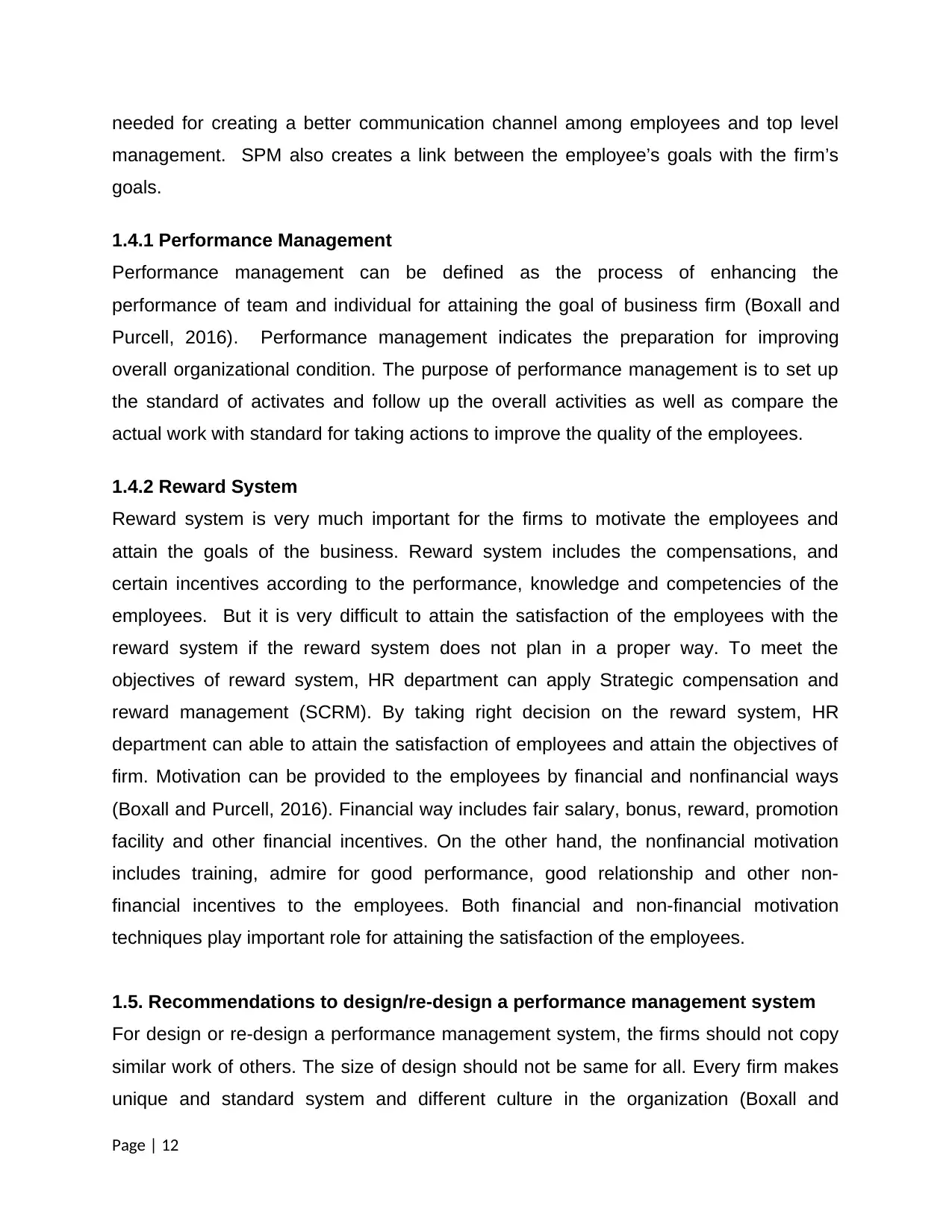
needed for creating a better communication channel among employees and top level
management. SPM also creates a link between the employee’s goals with the firm’s
goals.
1.4.1 Performance Management
Performance management can be defined as the process of enhancing the
performance of team and individual for attaining the goal of business firm (Boxall and
Purcell, 2016). Performance management indicates the preparation for improving
overall organizational condition. The purpose of performance management is to set up
the standard of activates and follow up the overall activities as well as compare the
actual work with standard for taking actions to improve the quality of the employees.
1.4.2 Reward System
Reward system is very much important for the firms to motivate the employees and
attain the goals of the business. Reward system includes the compensations, and
certain incentives according to the performance, knowledge and competencies of the
employees. But it is very difficult to attain the satisfaction of the employees with the
reward system if the reward system does not plan in a proper way. To meet the
objectives of reward system, HR department can apply Strategic compensation and
reward management (SCRM). By taking right decision on the reward system, HR
department can able to attain the satisfaction of employees and attain the objectives of
firm. Motivation can be provided to the employees by financial and nonfinancial ways
(Boxall and Purcell, 2016). Financial way includes fair salary, bonus, reward, promotion
facility and other financial incentives. On the other hand, the nonfinancial motivation
includes training, admire for good performance, good relationship and other non-
financial incentives to the employees. Both financial and non-financial motivation
techniques play important role for attaining the satisfaction of the employees.
1.5. Recommendations to design/re-design a performance management system
For design or re-design a performance management system, the firms should not copy
similar work of others. The size of design should not be same for all. Every firm makes
unique and standard system and different culture in the organization (Boxall and
Page | 12
management. SPM also creates a link between the employee’s goals with the firm’s
goals.
1.4.1 Performance Management
Performance management can be defined as the process of enhancing the
performance of team and individual for attaining the goal of business firm (Boxall and
Purcell, 2016). Performance management indicates the preparation for improving
overall organizational condition. The purpose of performance management is to set up
the standard of activates and follow up the overall activities as well as compare the
actual work with standard for taking actions to improve the quality of the employees.
1.4.2 Reward System
Reward system is very much important for the firms to motivate the employees and
attain the goals of the business. Reward system includes the compensations, and
certain incentives according to the performance, knowledge and competencies of the
employees. But it is very difficult to attain the satisfaction of the employees with the
reward system if the reward system does not plan in a proper way. To meet the
objectives of reward system, HR department can apply Strategic compensation and
reward management (SCRM). By taking right decision on the reward system, HR
department can able to attain the satisfaction of employees and attain the objectives of
firm. Motivation can be provided to the employees by financial and nonfinancial ways
(Boxall and Purcell, 2016). Financial way includes fair salary, bonus, reward, promotion
facility and other financial incentives. On the other hand, the nonfinancial motivation
includes training, admire for good performance, good relationship and other non-
financial incentives to the employees. Both financial and non-financial motivation
techniques play important role for attaining the satisfaction of the employees.
1.5. Recommendations to design/re-design a performance management system
For design or re-design a performance management system, the firms should not copy
similar work of others. The size of design should not be same for all. Every firm makes
unique and standard system and different culture in the organization (Boxall and
Page | 12
⊘ This is a preview!⊘
Do you want full access?
Subscribe today to unlock all pages.

Trusted by 1+ million students worldwide
1 out of 21
Related Documents
Your All-in-One AI-Powered Toolkit for Academic Success.
+13062052269
info@desklib.com
Available 24*7 on WhatsApp / Email
![[object Object]](/_next/static/media/star-bottom.7253800d.svg)
Unlock your academic potential
Copyright © 2020–2025 A2Z Services. All Rights Reserved. Developed and managed by ZUCOL.




